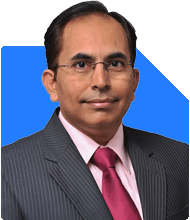Ramalingam Kalirajan |10870 Answers |Ask -Follow
Mutual Funds, Financial Planning Expert - Answered on Jun 26, 2025
He has an MBA in finance from the University of Madras and is a certified financial planner.
He is the director and chief financial planner at Holistic Investment, a Chennai-based firm that offers financial planning and wealth management advice.... more

Hello Sir, I am 38 years old and having very vulnerable life style with very bad management of fund and finanees. Completely ruined my money, currently earning 1.5 lac monthly and sole earner in family. Have housing loan of 65 lac interest rate 8.7%, personal loan from app around 4.6 lac interest rate 13.5% No savings at all... have only health insurance for family. Please guide how to manage the funds and currently paying 56k for home loan emi rest household expenses are around 40k- 50k.
Monthly income is Rs.1.5 lakh.
You have a housing loan of Rs.65 lakh at 8.7% interest.
You have a personal loan of Rs.4.6 lakh from an app at 13.5% interest.
You pay Rs.56,000 per month as home loan EMI.
Household expenses are Rs.40,000–50,000 per month.
You have no savings.
You only have family health insurance.
I commend your honesty in seeking help. You have solid income. Now, we must fix cashflow and rebuild.
Immediate Objectives
Reduce high?interest debt quickly.
Create a small emergency fund.
Improve monthly budgeting.
Start disciplined investments with guidance.
Secure your family’s financial protection.
Step 1: Personal Loan Repayment
Your loan from app carries 13.5% interest.
This is highest priority to clear.
Use any available extra income to pay it off.
Consider using part of future bonus or salary increment.
Freeing this liability reduces financial stress quickly.
Step 2: Revise Household Budget
Your expenses (40k–50k) are high relative to discretionary income.
Track each expense for a month to find savings.
Cut non?essential spending sharply.
Reduce dining, subscriptions, travel unless necessary.
Aim to lower expenses to Rs.30,000–35,000.
This will free up surplus for debt and savings.
Step 3: Build Emergency Fund
You currently have no savings.
Begin with a small goal of Rs.50,000.
Keep this in safe liquid account like bank or liquid fund.
Use any surplus until that fund is built.
This protects you from unforeseen situations without new loans.
Step 4: Home Loan Strategy
Your home loan rate is 8.7%, moderate.
Focus on clearing personal loan first, then address this home loan.
Once personal loan ends, channel that EMI to extra home loan repayment.
Additional payment reduces interest and tenure over time.
Step 5: Investment & Wealth Building
Equity and Actively Managed Funds
To grow wealth, equity investment is essential.
You may consider starting SIPs in equity.
Avoid index funds as they only track benchmarks.
They lack active risk adjustments in weak markets.
Instead, choose actively managed mutual funds guided by CFP.
Active funds can shift strategy during market volatility.
They aim to outperform through market cycles.
Direct vs Regular Mutual Funds
Direct funds save you commission but lack ongoing advisory.
Without CFP support, you may react or shift too often.
Regular plans allow your CFP to provide periodic rebalancing.
That guidance helps you stay focused on goals.
YouTube alone cannot replace professional insight.
Debt and Stability
Invest in safe debt instruments once emergency fund is set.
Use small monthly amounts in PPF, EPF, or debt funds.
These protect principal and complement equity risk.
Step 6: Systematic Investment Plan
Automate investment after debt payments reduce.
Start small; even Rs.5,000 monthly in equity is helpful.
Increase SIPs as home loan repayment frees monthly cash.
Diversify across large?cap, mid?cap, and flexi?cap active funds.
Review yearly with your CFP to adjust allocation.
Step 7: Insurance and Protection
You have health insurance. That’s good.
But you need term insurance to cover home loan liability.
Term cover ensures family stays financially safe.
Avoid investment?cum?insurance products like ULIP.
They cost more and give poor returns compared to active funds.
Step 8: Tax Efficiency
Equity mutual funds: LTCG above Rs.1.25 lakh taxed at 12.5%.
Short?term gains taxed at 20%.
Debt funds taxed as per your income slab.
Use PPF, EPF for deductions under section 80C.
Plan redemption to minimize tax impact on gains.
Step 9: Behavioural Discipline
Stick to SIP plans even during market dips.
Do not react emotionally to daily news.
Your CFP will guide you during volatile markets.
Review portfolio annually; rebalance only with advice.
Document goals and track progress.
Step 10: Progress Monitoring
Months 1–3:
Aggressively repay app loan EMI.
Reduce household expenses.
Build Rs.50k emergency fund.
Months 3–12:
Clear personal loan.
Begin small equity SIPs.
Keep liquidity for emergencies.
Year 2–3:
Use freed EMI cash to start big SIPs.
Build equity allocation gradually.
Start extra payments on home loan.
Year 3–5:
Home loan EMI surplus becomes investment.
Emergency fund grows to 6 months’ expenses.
Portfolio diversifies in equity and debt.
Year 5 onward:
Maintain SIP discipline.
Increase investments with career growth.
Annual review for rebalance and tax planning.
360?Degree Strategy Summary
Debt: Clear high?interest loan first, then home loan extra payments.
Budget: Cut non?essentials to free monthly surplus.
Emergency Fund: Start building immediately.
Investments: Active equity SIPs via CFP, complement with debt instruments.
Insurance: Add term insurance to protect family.
Cashflow: Automate savings and investment.
Tax: Use 80C instruments and time investments wisely.
Behaviour: Stay disciplined through market cycles.
Review: Annual check with your Certified Financial Planner.
Final Insights
You are determined and have a clear income path. By clearing high?cost debt first, you free monthly surplus for savings. Emergency fund protects from setbacks. Active mutual funds, guided by CFP, will rebuild your wealth steadily. Home loan extra payments reduce interest. Insurance ensures your family stays protected. With regular discipline, budgeting, investment, and annual review, you can regain financial freedom and rebuild a strong financial future.
Your journey starts with small steps today. Stay focused and seek CFP guidance whenever needed.
Best Regards,
K. Ramalingam, MBA, CFP,
Chief Financial Planner,
www.holisticinvestment.in
https://www.youtube.com/@HolisticInvestment
You may like to see similar questions and answers below
Ramalingam Kalirajan |10870 Answers |Ask -Follow
Mutual Funds, Financial Planning Expert - Answered on May 13, 2024
Ramalingam Kalirajan |10870 Answers |Ask -Follow
Mutual Funds, Financial Planning Expert - Answered on Jul 10, 2024
Ramalingam Kalirajan |10870 Answers |Ask -Follow
Mutual Funds, Financial Planning Expert - Answered on Jul 13, 2025
Janak Patel |71 Answers |Ask -Follow
MF, PF Expert - Answered on Sep 29, 2025
Dr Dipankar Dutta |1836 Answers |Ask -Follow
Tech Careers and Skill Development Expert - Answered on Dec 05, 2025
Ulhas Joshi |280 Answers |Ask -Follow
Mutual Fund Expert - Answered on Dec 05, 2025
Dr Dipankar Dutta |1836 Answers |Ask -Follow
Tech Careers and Skill Development Expert - Answered on Dec 04, 2025
Ravi Mittal |676 Answers |Ask -Follow
Dating, Relationships Expert - Answered on Dec 04, 2025
Anu Krishna |1745 Answers |Ask -Follow
Relationships Expert, Mind Coach - Answered on Dec 04, 2025
Anu Krishna |1745 Answers |Ask -Follow
Relationships Expert, Mind Coach - Answered on Dec 04, 2025
Mayank Chandel |2562 Answers |Ask -Follow
IIT-JEE, NEET-UG, SAT, CLAT, CA, CS Exam Expert - Answered on Dec 04, 2025
Mayank Chandel |2562 Answers |Ask -Follow
IIT-JEE, NEET-UG, SAT, CLAT, CA, CS Exam Expert - Answered on Dec 04, 2025
Mayank Chandel |2562 Answers |Ask -Follow
IIT-JEE, NEET-UG, SAT, CLAT, CA, CS Exam Expert - Answered on Dec 04, 2025
Mayank Chandel |2562 Answers |Ask -Follow
IIT-JEE, NEET-UG, SAT, CLAT, CA, CS Exam Expert - Answered on Dec 04, 2025
























